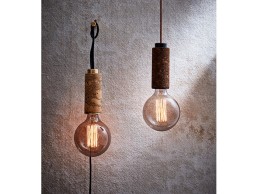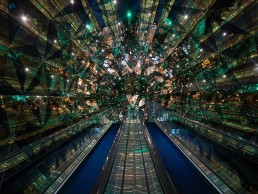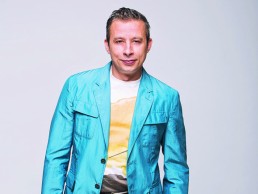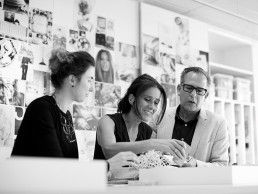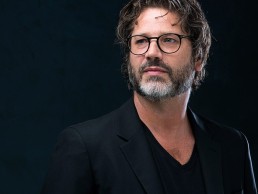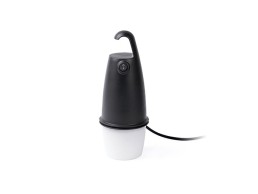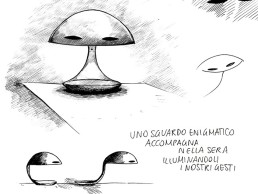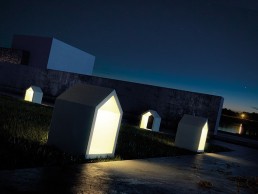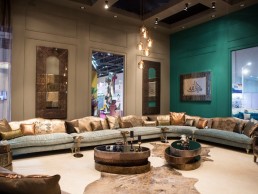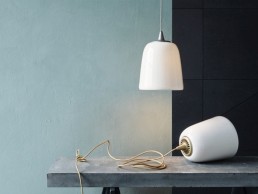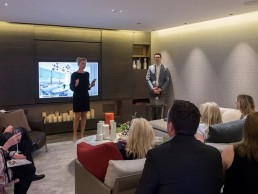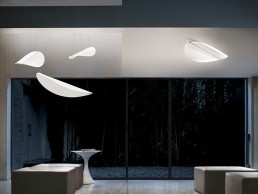NOVE - The Cork Collection
Created by Kirsty Saxon, an interior stylist and designer, NOVE’s beautiful marbled cork lights came to fruition from many years of styling trips to Portugal and a love of the natural beauty of cork. Together with Craig Lowe (her partner of nearly ten years) Saxon has developed NOVE’s first lighting collection, The Cork Collection.
The collection has a fresh approach to design –led lighting solutions, sustainability and local craft.
1880, Singapore
Overlooking Robertson Quay in Singapore, the 22,000sqft members club 1880 takes its name from the decade the quay was established. Founder Marc Nicholson and CEO Luke Jones envisioned a design that would spark imagination and encourage unplanned conversations and engaged Timothy Oulton Studio to do just that.
“When I spoke with Marc and Luke and learned about their ideas for upending the traditional old style members club, and creating a place where life and work all come together in a totally modern way, it just seemed right up our alley,” Timothy Oulton tells darc. “They wanted to create somewhere that would encourage unlikely connections and unplanned conversations. Part of the brief was to create a home away from home for both the diverse membership from Singapore as well as their international members, so incorporating both Asian and Western elements into the design was very important and flexibility was key. 1880 has a really varied program so they didn’t want the design to limit the type of activities and events they could hold, and that was a challenge.”
The studio responded to the brief with a multi-sensorial design, seeking to activate and energise the senses at every turn. Members enter through a kaleidoscope tunnel, a portal that separates the outside world from the club. Ascending the escalator, members arrive at the Rose Quartz reception desk, a 1.5 tonne rock crystal, mined from Madagascar. This 25 million year old mystical love stone emits energy under pressure – the piezoelectric effect.
One of Timothy Oulton Studio’s biggest projects to date, 1880 is also the first co-working space the studio has designed. “The workspace is different from a breakout space, which is what we’ve been known for, but now we’re learning both disciplines,” says Oulton. "The space is called Bardo, a Tibetan word that means ‘intermediate state’, just below heaven limbo an idea of blending work in. That’s what 1880 does – it blurs that line between work and leisure because there’s no such thing as a traditional work life balance anymore, its just life. My favourite features of the club are the reception desk and the kaleidoscopic tunnel entrance, it’s covered in mirrored triangles that play with the light. We wanted to create an experience that felt as though you were being transported into the world of 1880.”
One of the club's highlights, where work and leisure blur together is The Double, a casual café in the daytime, suitable for relaxing or holding a business meeting, which dramatically transforms into an intimate, seductive bar at night. As the sun goes down, a hidden, fully stocked bar shelf is lowered from above, elegant lighting appears from the ceiling and the leather banquettes rotate to face the bar, cocooned by a sweeping silk curtain adorned with a golden dragon.
Reclaimed mahogany flooring has been used in The Studio, to allow for the array of casual and formal activities held here, black velvet drapery can be pulled back to reveal an entire wall of antique mirror panels when a more glamorous atmosphere is called for. Inbuilt cupboards made from reclaimed English timber house the technical equipment for the in-house cinema and
the wine cellar forms the backdrop to Leonie’s Restaurant, where burnt timber arches stand at just under three metres high. Multiple brass rods connect the arches, supporting 700 wine bottles, each one individually lit.
In the lobby, the Cabinet of Curiosities is filled with curios from Oulton’s personal antiques collection, while in the members lounge 360 antique English teapots are contrasted against a wall of reclaimed bricks etched with Chinese motifs. 1880 is built around the concept of colliding ideas, a place to forge unlikely connections. Old things need revisiting and rethinking, to be made relevant today.
The club's curated membership of movers and shakers is a melting pot of personalities, including both locals and ex-pats, and Asian and Western influences have been incorporated throughout the club, along with feminine touches for a lighter atmosphere.
Versatility was a key element of the brief for Oulton, from private dining to board meetings, yoga, salon discussions and private events, the extensive programming in the club means that the rooms are in constant demand and serve multiple functions. “The brief definitely developed over time, the initial discussions we had with Founder, Marc Nicholson, were very collaborative as we began to map out how the space would be used, Oulton says. “The events programming followed later and with this the demands on each space increased. Every space needed to become more adaptable and flexible than originally discussed. We wanted to ensure that when you are in the space the design lends itself to how the room is being used at that time and elevates the overall experience.”
It was vital to the design that the different spaces in the club connect and the lighting is one of the main ways that this was achieved. The private dining room is styled quite differently from The Double, but the walls between the two spaces can open up if needed, connecting them for larger events. The feature lighting is the same in both areas helping tie them together when the space is opened up.
The lighting in Leonie’s brings a subtle elegance to daytime dining but in the evening the nine Night Rod pendants are much more of a dramatic, romantic feature of the space. Similarly, The Double which serves as a casual café in the day transforms at night to a theatrical but intimate cocktail bar: the banquettes turn, the silk curtain is drawn and the bar shelf and feature lighting descend from the ceiling. “We wanted the space to be almost unrecognisable after the transformation, and the lighting plays a really big part in that,” Oulton continues.
The feature lighting in the club was all made in-house. Night Rod, Core, Stellar, and Gradient are from the Timothy Oulton collection, Khan is from Halo Established, and the Flame bar lamp and Carrousel pendant were custom made by Timothy Oulton Studio. The Gradient pendant was chosen because of its impressive scale, which links with the feature columns in the Members Lounge and Leonie’s restaurant. Flame was handblown in the studio’s in-house glass workshop, the soft organic shape contrasts beautifully with the harder metallic lines of the bar while Carrousel draws its inspiration from traditional Chinese lanterns. Khan was used in the club lobby, its circular form and different sizes allowed the designers to play with positioning the lights along the entire length of the lobby as a way of connecting the different areas in the club and also to act as a subtle marker for some of the secret hidden doors.
“As with any project there is always some degree of modification as the concept develops and evolves but one thing that remained constant throughout was the dedication to using reclaimed materials,” Oulton says. “They’re authentic and they bring character to the space, which works together with other design elements to create a truly unique environment.
"With the lighting, we wanted to create an atmosphere that is comfortable but at the same time makes each individual feel special, it is the details and considered elements of the design that come together to do this and lighting is an important part of that.” 1880 is an environment designed to energise the senses and provoke conversation; every detail has been designed to spark the imagination. For Oulton, luxury is not about things, its about experiences, meaning and connection. “I wouldn’t change anything about this project, that’s not how we look at it,” he says. “The space was designed to bring people together, there will always be some elements that people might respond differently to but that’s part of what makes it interesting, it starts a conversation or a discussion and in doing so provokes interaction.”
Filipe Lisboa
VISO’s headquarters is located in downtown Toronto with global satellite offices in Portugal and Dubai. Led by Founder and Head Designer Filipe Lisboa and Managing Partner Tzetzy Naydenova, the couple have bound their efforts in design, production, management and marketing to build a strong, reputable, and unique fashion forward lighting company.
Lisboa’s design story begins in Portugal, where he lived until the age of nine before his family emigrated to Canada. At 26 he moved back to the country he left in search of new opportunities with a young family in tow. He began working for his family’s business setting up the sales and distribution channels but always knew he would eventually branch out on his own.
Lisboa first move into design, came shortly after watching his small children slip and fall on the tiled floor of their traditional Portuguese home, he realised that adding leather to the soles of their slippers solved the problem and his first company Tippie Toes was born. The company was a huge success, Lisboa travelled around Europe taking part in trade shows and immersing himself further into the design world, where he discovered an LED light that sparked his imagination -this was the moment VISO came to life. Lisboa designed VISO’s first collection in 1998, utilising translucent materials such as glass, opal and plastic. Noticing that Italy was the only go-to country for contemporary lighting he wanted to create something similar but making use of Portuguese industry and producers.
“From the very beginning ‘light is life’ has been the motto that has driven our approach towards design,” Lisboa says. “For us it’s about following what the market wants and the inspiration at that particular point in time.
“There is such a transformative power in lighting, transforming day to night, transforming internal spaces into calm and relaxing spaces. Lighting is such an integral part of everyone’s daily life and as a designer I carry that thinking in to every project. Lighting products and design should help tell the story of the entire space. It should transform the environment and bring warmth and uniqueness to every project. Shadow and depth is also a consideration in order to create an engaging dynamic setting.”
What it shouldn’t do as far as Lisboa is concerned is compromise. “For me the key elements are material, technology, design and function, the greatest pieces strike the perfect balance between all of them,” he says. “The Dyson Cu-beam suspension light represents the best and the worst developments in product design - the technology is amazing with its heat-pipe technology to cool the LEDs. But the light lacks a product design element. They sacrificed the entire design piece to create a technological marvel, but that’s not what lighting design is about. It’s about finding that perfect balance between the two.” For Lisboa, complying with the limitations of manufacturing can be frustrating but not without its rewards. “Our imaginations are our greatest source of inspiration but we operate within the physical space, and from an engineering perspective we need to consider longevity, materials and cost,” he explains. “But on the flip side the most rewarding thing is seeing the finished product and the joyous reaction of the client with the final outcome.”
There is a lot that Lisboa has to balance day-to-day, aside from being the CEO, he leads the sales team as well as the design direction of the company, but designing the next stand out piece is never far from his mind.
Lisboa brings his unique, uncompromising perspective of light to all of VISO’s projects, but the most notable ones, are the projects where the light becomes art, where glass and copper weave in and out of existing heritage woodwork, illuminating the seating below in a fixture that is both functional and stunning. The company recently worked with design firm Yabu Pushelberg on the Four Seasons Hotel Kuwait (featured in issue 26 of darc) and the FIVE Hotel and resort in Dubai creating beautiful brass dandelion chandeliers, pared back gold globe pendants and unique brushed brass wall sconces all with a contemporary yet timeless aesthetic, something that Lisboa predicts will be around in the design world for quite a while. “We’ve recently seen design move towards a more organic aesthetic, coupled with antique finishes like hairline bronze,” he says. “The work of Henge and Roll and Hill reflects this perfectly - I think we’ll see a continuation of this trend towards more clean and simple lines as people look to simplify their lives from all the distractions.”
Kendra Pinkus
darc discovers how fashion influences the choices Kendra Pinkus makes when working with her team at Australian interior design firm Bates Smart.
Bates Smart is a multidisciplinary design firm delivering architecture, interior design, urban design and strategic services across Australia, with over 300 staff in studios across Melbourne and Sydney. The company’s award-winning projects transform the city fabric and the way people use and inhabit urban spaces and built environments.
Kendra Pinkus, an Associate Director at Bates Smart, has been with the company for over 20 years and worked on the Crown Perth project (featured in darc issue 19) alongside Director Jeff Copolov.
Here, we delve deeper into her passion for interiors and how lighting plays an integral role to any project.
Design was deeply embedded in Pinkus from an early age having grown up in a family of fashion designers and found herself constantly surrounded by leather, fabric and shoe samples. While there was never any pressure to continue in the family business and work within the fashion industry, it has, inadvertently become one of the designer’s key reference points for inspiration.
“I relate fashion to interiors all of the time,” Pinkus tells darc. “With fashion, every piece has to be finely tailored and have a point of difference but, most importantly, a fashion item has to be comfortable and wear well. I believe interiors share a similar approach where each piece must work for the client’s needs and ultimately the end-user.
“Fashion is often the lead for inspiration when I start an interiors concept. Every mood board incorporates a fashion element, such as patterns or colour palettes. A beautiful pleat of a dress could inspire a light fitting, a handbag clasp could emerge as a handle detail and a stitch in a jacket lining could be transformed into a decorative cushion.
Having changed schools at 14 years of age to one that was more aligned with the arts, Pinkus spent as much time as she could during lunch breaks and school holidays in the art department and confesses, as a child, she would much rather take a suitcase of arts and crafts on holiday than a suitcase of clothes. “That school changed my life,” she says. “As soon as I walked in I was like a kid in a candy store – there were five levels to the art department! This is where I discovered graphics and interiors. At the end of my time there, I asked my graphics teacher for guidance as to whether I should place interiors or graphics as my first option – there was no need for an answer and my final thesis delivered was on a hotel interior. Interior design was not particularly a choice, rather my career destiny.”
As is usually the case, the transition from education to employment for Pinkus wasn’t a straightforward one. Having applied for the only school available for interior design, unfortunately Pinkus was not accepted. Determined to follow her passion in interiors, she declined the opportunity to study industrial design and instead joined a large architectural firm, which cemented her passion for interiors.
“I was at the firm for about a year and absolutely loved it – it was the perfect experience following school and I absorbed everything I could. I was seated right next door to the head of interior design– she was so inspiring! I then reapplied to RMIT’s school for interior design and I was accepted– this is where my journey really began.”
To support herself through university, Pinkus took a job in retail, which inadvertently taught her an important tool: how to study people and understand their needs. “I learnt about understanding the customer and articulating what they wanted. This is an essential skill for interiors – you are always selling ideas to your client and need to ensure it meets their needs. This is the same in fashion retail – you need to not only style the customer but ensure they can wear the style with confidence and ensure it works with their own personal brand. It’s all about collaborating with your client, working with them and sometimes holding their hand through the journey.”
Pinkus may have been with Bates Smart for over 20 years but, just like university, it wasn’t the smoothest of starts. “It’s a funny story really, a friend of mine worked in one of the offices Bates Smart was affiliated with at the time and so I gave him my CV to pass on to Interior Design Director, Jeff Copolov. To cut a long story short, I was told it ended up in the bin, which I was devastated by. Bearing in mind I was a poor student who had spent all of my money on printing my CV on extra thick, quality paper – all one sided too!
“It wasn’t meant to be at that time, but two years later I reapplied and sent my CV to the HR department this time… the rest is history, as they say! I was excited to join a studio that delivered such exquisite work with so many other designers to be inspired by.
“The first ever project I worked on with Bates Smart as a young graduate was a prestigious residential project where I really learnt my craft and I still refer to today. We delivered everything from the architecture through to selecting the soap dishes. When I walked back on site after completing the job, I realised for the first time how lucky I was to have found a career that I loved and be surrounded by creative people. I am proud to be part of the process in creating memorable places that people engage with and can take joy from every day.
In terms of ‘design style’, Pinkus always starts a project with a pure backdrop to build upon the creative inspiration. She tells darc, it’s all about articulating the brief, understanding the client’s needs and the end-user and how much you humanise it. “Each client has varied needs and parameters they wish to work within so it can be about how far you can turn the volume up to meet their requirements.”
“I believe, like fashion, interiors should be timeless – you want to be able to walk through the space in years to come and you should still feel that the space is uplifting. I always try and keep the interior architecture quite elegant, calm and classic, particularly the hard finishes that are often more difficult to replace. The creative opportunity lies in the soft furnishings where you have the freedom to create a fun and engaging environment that can be refreshed easily, such as cushions, rugs and armchairs.”
“I don’t generally prescribe to trends as they are fast moving and ever-changing. The other day, someone was telling me that we shouldn’t use arches in a space… why not? Arches have been around forever and can have a relevance for certain interior designs. As designers, we should follow our instincts and not simply follow trends or dismiss former designs, everything can have a place if it’s right for the environment.”
Talking more specifically about working with lighting, Pinkus says it is an essential ingredient for interior design. “It’s the first and last thing I think about when working on a job. Lighting can affect the experience and mood of a space and must be an early consideration. I relate it to theatre production, which is all about lighting. You’re taken through a journey of how the production designer wants you to experience each scene as the performance evolves. It’s all about painting each scene with light and creating subtle moments for your audience to experience. It’s the same with interior design: lighting transforms the mood and ambience. Lighting can transform objects and bring them to life.”
“We always work with specialist lighting consultants, such as Electrolight, Point of View and Vision Lighting, to define the mood we wish to create. Each fitting is considered depending on the environment and the requirements throughout the day.
Pinkus explains: “Architectural lighting should never be seen – the client and end-user should never really know it’s there, it’s more of a feeling and shifts the mood of the space throughout the day. Whereas the decorative lighting – well that’s all about the props and the theatre, it’s about how many moments you want people to concentrate on, creating the drama and mood.”
Looking back in particular at the Crown Towers project, which featured a bespoke lighting installation from Willowlamp, for Pinkus, this is one of her most notable projects to date, saying: “I knew the lobby needed something significant that would make an impact. I discovered lighting artist, Adam Hoets online and went over to South Africa to see him… the conversation grew to him designing a bespoke light fitting. The technology behind it is incredible. When you see it in real life, the beauty of the piece instantly resonates. There’s a kaleidoscope of light and colour that comes alive – it has becomes a centrepiece that wows the guests that arrive at the lobby.”
Looking ahead, the Bates Smart team has many significant projects in the pipeline from a beautiful five-star hotel in Darwin that overlooks the waterfront, featuring handcrafted lighting elements to a high-end luxury residential apartment building such as 85 Spring Street in Melbourne; the new club stand for the Victoria Racing Club in Flemington just in time for Melbourne’s Spring Racing Carnival and the Australian Embassy in Washington that is inspired by the national landscape.
Interior design in Australia is booming right now and while every industry has its frustrations, for Pinkus this only inspires her and the rest of the team to work harder and think in a more creative way. “Project limitations push you to think of an alternative,” she says. “When I was younger I found it frustrating but now, it’s just part of the creative process. Good, solid interior design is about longevity, harmony and simplicity. It’s about applying soft layers to it, the key elements that allow your eye to move through the space easily. Working with light is a subtle artform – as are the music notes used to play a symphony – it has the ability to paint a scene and create memorable experiences.”
Paul Bishop
darc speaks with interior designer Paul Bishop on his work across the Middle East, design trends in the region and how he finds inspiration through travel.
Founded by Paul Bishop in 2004, Bishop Design continues to work on high-end projects across the entire MENA region as well as internationally. An award-winning portfolio of commercial, hospitality, retail and residential projects have been secured through recommendation, referral and repeat business – a true endorsement of the company’s abilities. The success is mainly owed to the dedication and personal touch that is applied to each and every project executed.
With over 60 awards under Bishop Design’s belt, both regionally and internationally, the firm’s continued execution of well-planned design solutions has led to an ever-increasing portfolio, which today, includes hundreds of projects worldwide.
Born in Croyden, London, one of Bishops’ biggest passions growing up (alongside athletics) was art, which led him to attend Brighton School of Art. Immersing himself in all aspects of design from fashion and textiles, through to theatre, graphics, furniture and product design, in these early years his aspiration was to pursue a career as a fashion or theatre set designer.
“It wasn’t until I went to Kingston University to study furniture and product design that I discovered interiors,” he tells darc. “From there, I knew it was the direction I wanted to take and I went on to study a Masters in interior architecture at Manchester University. I consider myself incredibly fortunate to have studied at these esteemed universities and honoured to have had my mind inspired and shaped by such lecturers along the way, from the likes of Eric Owen Moss to Lord Norman Foster.”
The opportunity soon arose to move to Dubai – at the time, a somewhat unknown location. With a vague idea of where the city was, Bishop was shocked to find just a handful of buildings in the entire city. “My career only really took off when I came to Dubai,” he says. “Upon graduating I was tour managing and producing music videos and prior to this I had taken on evening and weekend jobs while studying in the UK. These varied from bar work to high-end retail sales, but all of them shaped me in some way, as these are particular sectors of design we specialise in.
“Once I got to Dubai I worked as a senior interior designer for a number of companies before being given the opportunity to move to Singapore as the Design Director for Wilson Associates, but I just couldn’t turn my back on Dubai. The city was a blank canvas with so many opportunities and it was here that Bishop Design was born.
“Twenty two years on and the city is booming; it amazes me every day the changes we’ve witnessed in the region. It’s such an amazing experience to have worked on so many of the hospitality venues in Dubai and to work on a project from the onset to final delivery.”
When asked about the use of light in his designs, Bishop says: “It’s everything. It is integral to all interior environments and is 90% of achieving the desired, unique ambience and atmosphere to animate the interior.
“We have worked with Aculite, Preciosa Lighting and Nulty+ on previous projects,” Bishop continues. “In addition to more specialist designers such as John Cullen Lighting, Lightflume and PSLAB - all very professional and a pleasure to work with. We also select and specify lighting for the majority of our projects in house, it’s only when clients require something a little more specialised that we might look at bringing a partner on board.
“In an industry where there is an endless choice, suppliers that stand out for me are those that continuously create new and innovative solutions, in addition to bespoke solutions developed and created with the designers already mentioned. We also work closely with manufacturers such as Moooi, Karman and Minehart to mention a select few that bring original concepts to market and are a collation of my personal favourites.”
Lighting in general within the Middle East is, according to Bishop, becoming a much more considered element of design and new ways of incorporating it into interiors are continually being explored. “Not just as a fixture,” he says, “but also considerably more as an animator as we continue to explore unique and more original solutions to enhance the lighting experiences in the interiors. So we are extremely diverse in our design and appreciation, as all these elements are fundamental. With that in mind we carefully consider whichever suits the design better from either technical, decorative lighting to 3D and virtual mapping.”
With design heroes as eclectic as Vivienne Westwood, Ettore Sottsass and Carlo Scarpa to Marcel Duchamp, Ron Arad and Jamie Reed, Bishop naturally draws inspiration from all of these celebrities of design, but tells darc he is most inspired when travelling.
“It’s a struggle to find inspiration from a laptop as you have to be so specific as to what you’re looking for and your mind is concentrated on just that one thing, yet when you are walking around and immersed in different cultures, you take inspiration from everything.
“No matter how subtle or obvious something may be, I draw inspiration from everything – we need to open our minds to connect to that initial piece of information and then evolve it into something of our own.
LA, Miami and New York are iconic for design and are my personal favourite destinations as their restaurants and street cultures inspire me so much for my own design here in Dubai and internationally.”
After two decades in Dubai, Bishop tells darc he still gets the same excitement he did back then… walking into the office in the morning and knowing that every day will be a different experience.
“It feels amazing to have worked alongside some of the most of creative minds and incredible brands,” he continues. “One in particular being world-renowned Chef Massimo Bottura while working on his new Italian offering, aptly named Torno Subito located at the W Hotel, Palm Jumeirah. Designing for such an inspirational, creative mind such as his has deifnintely been a notable part of my career. We had to bring to life his vision without him actually knowing what this was, which I believe was the biggest challenge. All projects have challenges of course, but this is what makes life and particularly a designer’s life, so exciting!”
With such growth in the region, Bishop Design has also worked hard over the last year to set up subdivision Rogue, the alter-ego to Bishop Design. It gives the studio more freedom to explore a cheekier and slightly more provocative approach to interiors, as well as allowing a progression into other fields including architecture, branding and creative media. “We’ve also taken on some exciting international projects in the Bahamas, London, Paris and Mauritius with our recent decision to expand further internationally. We also expect to expand the brand even further, establishing offices and representation in Los Angeles and Miami over the next year.”
For Bishop, when considering interior design, you should consider a narrative. “Interiors are experiential,” he says. “When guesrts leave a venue it’s not a particular colour or a certain piece of furniture, but rather the ambience, visual dynamic, the experience had and memories made. It is essential that they are able to move and travel freely within the space, while the operators are able to fulfil their needs also.
“A thoughtfully approached layout allowing for maxium efficienct use of the space by both the operator and the client, as well as carefully selected palette, styling, finishes, furniture and ultimately lighting to allow for the upmost comfortability are the key elements of any successful interior.
“Lighting is the nucleous of every interior with the ability to alter one’s visual perception of colour, furniture, details and accessories. It cannot be overlooked as it has the power to make or break any space.”
Faro Barcelona’s Hook light wins Reddot Design Award
(Spain) - Faro’s most socially conscious project to date wins Reddot Design Award.
Faro Barcelona received the Reddot Design Award for its portable luminaire, Hook. Judged by an independent jury of 40 reputed experts of design, the Reddot Awards are divided into three categories: product Design, communication design and design conception.
Judges were impressed by the brands social consciousness and the lights versatile yet sleek design. Hook is produced entirely in Spain from recycled bottle caps, Faro Barcelona commissioned OiKo Design Office, the design studio headed by Salva Codinach and José López-Aguilar to design the light. Environmentally friendly-Hook’s design optimises every phase of the lifecycle of its components in order to reduce environmental impact, its casings are made of recycled polypropylene, a sustainable plastic that is also present in the diffusor to encourage recycling.
Cobra reloaded contest winner announced
(Italy) - Cobra reloaded contest invited designers under 35 to reinterpret iconic light.
Martinelli Luce’s Cobra Reloaded design contest invited young designers under 35 to reinterpret the Cobra lamp – designed by Elio Martinelli in 1968.
A total of 82 projects were submitted to the contest by young designers from all around the world: Italy, Russia, Iran, France, Spain, Turkey, Bolivia, Brazil, South Africa, Australia. The jury was chaired by Emiliana Martinelli and included Morozzi, Paola Navone, Perla Gianni, Marco Ghilarducci, and Massimo Farinatti. The winners were announced on 29 June at Martinelli Luce’s Lucca showroom:
In first place was Veglia Luminosa designed by Elena Volpi, Second place was Good Design by Victoria Azadinho Bocconi, while third place went to Oops 50! designed by Gianmarco Paglierani.
The jury also awarded a special mention to the project Che cosa apparirà? by Mauro Favero.
B.Lux releases new LED beacon light by David Abad
(Spain) - B.Lux expands its outdoor collection with new LED beacon light, Whitehouse.
Designed by David Abad, White House is inspired by a gable-roofed house. The design references architecture with its shape, concrete body and white, grey or black finishes.
The outdoor light features two integrated LED lamps guaranteeing low consumption, optimum lighting and the capacity for installation in all kinds of gardens and terraces.
Silk Road theme announced for second INDEX design
(UAE) - INDEX hosts compact edition of show in September
INDEX is set to host a compact edition of its design showcase in September, where a Silk Road theme will bring value-driven products and premium brands to Dubai.
Autumn’s INDEX will focus on East meets West, with the show presenting itself as a modern- day Silk Road; the famous cross-continental design pathway that opened-up new markets for Asian and European design philosophies.
INDEX will welcome 400 furniture and décor design and supply companies from across the continents, all specialising in fit-out and interior products for commercial, hospitality, retail and residential design projects.
Samantha Macdonald, INDEX Event Director explained: “The Silk Road started over 2,000 years ago, and through its many routes became the first way that Europe and the West was introduced to the likes of silk, dyes, precious stones, porcelain, spices and perfumes. In return, the route took western goods like glassware, woolen textiles, rugs, carpets animal firs and skins to a new market in the East, making it the world’s first and then premiere trade route – at the heart of which was design and creativity.
“Its path ventured through the deserts of the Middle East. Two millennia on and the region – the UAE especially – plays equally as central a role now as being the hub between the two continents.
“INDEX September will focus on individual designs and value driven products from Asia, sat alongside premium products from Europe. Together, they will allow the show to present a wide selection of interior products to suit the taste and budgets of all our visitors, covering every buyer’s needs as the design industry heads into the final quarter of the year.”
The full INDEX experience will return in September 2019 as the show in its entirety sits alongside The Hotel Show Dubai.
To find out more about September's INDEX, taking place from the 16th – 18th, visit www.indexexhibition.com
Republic of Fritz Hansen introduces Dogu Light
(Denmark) - Republic of Fritz Hansen collaborates with Michael Geertsen.
Republic of Fritz Hansen and Lightyears collaborates with Danish artist, ceramicist and designer Michael Geertsen on the Dogu light, a simple and clean design idiom that casts a sensuous glow.
Michael Geertsen’s art is inspired by the correlation between sculpture and functionality, the Dogu light reflects Geertsen’s this with its organic silhouette and smooth surface.
The name Dogu is Japanese and refers to the traditional ceramic figures shaped like animals and manlike creatures, they had no utility value; however, they had great immaterial and emotional function. In the shape of Geertsen’s modern Dogu lamp, these properties are combined in a useful and aesthetic function - the moulded lampshade is made of bone china, a semi-transparent material made of white clay with bone ash. The light casts a soft and golden light, which characterises the Nordic tradition of applying light to bring out a certain mood and atmosphere. The small irregularities of the bone china resemble the natural marks of e.g. natural leather and add life and personality to the material, which accentuate the unique diversity of the lamps.
Dogu is curved from the cord to the base - from the bone china lampshade to the aluminium suspension. This suspension has small gaps, which cast the light upwards. The result is a pleasant, soft and diffused light.
Crestron Partners with interior design and lighting experts for FOCUS/18
(UK) - Crestron and partners will explore design at FOCUS/18.
Crestron, will be collaborating with editor and journalist/interior designer, Kate Burnett, and Lighting Designer Rebecca Weir, to explore the innovative ways light and bespoke smart home technology can enhance interior design, during this year’s FOCUS/18 event.
Burnett will be joining Crestron, along with selected Design Centre showrooms, to discuss the importance of brand collaboration and partnerships when designing and personalising a home automation project for a client. She will moderate an inspiring panel discussion titled ‘Collaborating in colour – bringing bespoke design to home technology’.
After training in interior design, Burnett worked in professional practice with one of the UK’s leading architects. She then returned to journalism specialising in contemporary design and architecture and was editor of idfx for over four years. After a period as a regular contributor to various leading titles including London’s Evening Standard, Financial Times, Blueprint and Elle Decoration, Kate launched Studio, a new title for professionals in high-end design. Studio is now published ten times a year as part of a print and digital platform centred around residential design.
As Creative Director for Light IQ, a leading lighting design company for the residential and commercial markets, Rebecca Weir will be joining Crestron to host a series of talks on ‘the colour of Light”. She will deliver 15 minute inspiring and practical presentations on lighting technology. Weir is passionate about harnessing and maximising the creative potential of light, by exploring and pushing the boundaries of illumination. This had led her to the successful completion of over 1,000 award-winning residential and commercial projects both in the UK and abroad.
As well as engaging in this year’s theme of colour and its positive power, the talks will provide visitors with the inspiration and positivity to go bold with smart technology to enhance interior design. To register for the Crestron Focus events, click here or visit the Crestron EMEA Showroom, 2nd Floor, South Dome, Design Centre Chelsea Harbour.
The Colour of Light – hosted by Rebecca Weir will be held on Tuesday 18th September:
11am – 11:15am
12pm – 12:15pm
1pm – 1:15pm
2pm – 2:15pm
3pm – 3:15pm
Collaborations in Colour – hosted by Kate Burnett will be held on Wednesday 19th September:
11am – 12pm
Honourable mention for Linea Light at Compasso D’oro Adi Awards
(Italy) - Linea Light’s Diphy LED pendant impresses jury at Milan Awards.
The international jury met in early May to consider the 283 products and designs of the prestigious ADI Design Index 2016 and 2017 selections. Of these, 16 received the Compasso D'Oro and 56 received an Honourable Mention.
Designed by Mirco Crosatto of Linea Light Group and inspired by extraordinary elements found in nature (its name comes from Diphylleia grayi, or the skeleton flower, which can be found in wet and cold wooded areas in Japan and China and whose white petals become as transparent as glass when they come into contact with water), Diphy combines functionality and design. A very thin aluminium bar painted white houses the LED source, whose clean light fills the PMMA diffuser, which distributes it, below. The extreme transparency counterbalances the brightness of the lit lamp, embellished by the characteristic pattern of laser micro-engravings .
The lamp is available both in a hanging version with dangling leaves that seem to fall while being pushed by a gentle breeze, and as a large, bright, curved floor lamp for both private and public environments.
Giovanni Noris, Marketing Manager of Linea Light Group, said, "We are very proud of the recognition we have obtained. It is further testimony to the excellence of the best Italian design, as is rightly highlighted in the communication we received from the ADI".
"In these first six months of the year some of our other products have won prestigious awards, such as the IF Design Award 2018 given to both Archiline and Reflexio: a sign that the road that we are travelling based on continuous research and innovation is the right one", Noris concludes.


